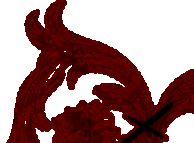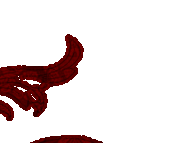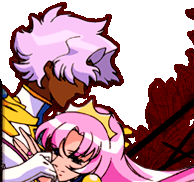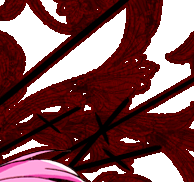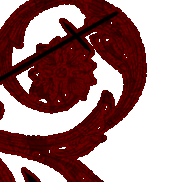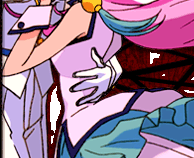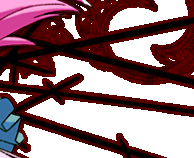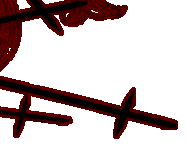
This analysis
was donated by Jane. 
In Anime: From Akira to Princess Mononoke, Susan J. Napier describes Lain (of Serial Experiments Lain) and Utena (of Revolutionary Girl Utena) as liminal girls, drawing parallels with Lewis Carroll's Alice books. It's one of the only instances I can think of where the two anime are put side-by-side. More often, you'll find either one compared to Neon Genesis Evangelion, and while it makes sense to do so, these two have more in common with each other than with Evangelion. In terms of style, tone and plot they appear completely different, but appearances are deceptive.
In broad strokes, both Lain and Utena are about naïve fourteen-year-old girls with opaque memories and only a vague idea of who they are. They move, like Alice, through liminal spaces. Reality isn't concrete; everything they think they know is uncertain. They are manipulated by entities who see them as the focal point of the uncertainty. It becomes difficult to separate illusion from reality. This affects their relationship with others and the world around them. What keeps both Lain and Utena grounded is their close friendship with another girl (Arisu for Lain, Anthy for Utena) that becomes romantic attachment. This emotional connection helps them make their ultimate decision: reject their manipulators and leave the familiar, illusory world behind, with the promise of being together with the person they love in some way.
The above plot outline is not unique to either series. Similar threads are followed in Puella Magi Madoka Magica and The Matrix, as well as in myths, parables and religions. Going deeper, though, this is not where the similarities end. Lain and Utena tell this kind of story in such a way that viewing one may help in better appreciating the other.
First of all, Lain and Utena are metafictional. Their realities are literally shifted by stories. This is more overt in Utena. Its director, Kunihiko Ikuhara, loves to use fairy tale motifs in a subversive way, similar to Angela Carter or Margaret Atwood. Utena's childhood memories are narrated as fairy tales. She genuinely believes she encountered a prince and that she will not only find him again but can become a prince too. Her peers, while a little sceptical, see this more as eccentricity than delusion, mostly because they are also trying to live up to fantasies. As well as fairy tales, Ikuhara also draws influence from theatre; his characters' dramatic behaviour and aristocratic outfits are clear signs that events are being performed on a metaphorical stage. Halfway through every episode, the Shadow Girls pop up to give Brechtian commentary on what's going on, drawing attention to the questionable reality of it all.
In Lain, reality is altered by a different kind of story, and through different mediums. In place of live performance, it takes influence from digital, recorded media and communications technology. Rumours and urban legends are spread online and this affects reality. As the human incarnation of the Wired (the internet), Lain is godlike; she is omnipresent and capable of restructuring the world in any way she wants.
Aside from the kind of fictions they explore, a key difference is that Utena has to escape her fairy tale world, venturing outside Ohtori Academy and becoming part of the wider, more real world. Lain literally alters the world; she can decide what reality is. And instead of becoming part of reality, she stays liminal. Lain creates a world where she never existed, observing everything as a phantom limb.
Despite handling metafiction in different ways, there is one scene in Lain that could easily fit into Utena narratively. In episode five, a younger Lain kneels in front of a series of floating images, including a doll, a mask and her mother. She asks them to tell her a story and they give her cryptic messages. It is a moment that mirrors Utena's distorted memories.
It's always jarring when modern technology appears in Utena, but it always feels deliberate. These devices clash with the carefully-constructed simulacrum of Ohtori Academy. They serve the same purpose as the Shadow Girls, reminding us that everything is a fabrication. The Shadow Girls love technology, hosting a late-night radio show and in Adolescence of Utena, the film adaptation, they commentate on Utena's escape from Ohtori via a high-tech set of monitors.
Technology manipulates light and shadow. It alters our perceptions. Even animation as a medium does this. In The Key by Junichiro Tanizaki, a sleeping woman's body looks different under electric light, more mesmerising to her husband than in candlelight. It reminds me of the scene in Utena where Anthy watches the stars cast by her brother Akio's projector, preferring them to those in the night sky. Meanwhile, her brother drives under streetlights, whose glow makes those real stars invisible. A difference in lighting can make things seem unreal, or at least real in a different way. In Lain, the city is lit by neon signs, traffic lights and the glow from office buildings, casting a haze over everything. In the daytime, deep shadows that resemble pools of blood are cast by artificial structures. They don't speak like the Shadow Girls do, but they are accompanied by distant voices and the hum of wires.
The motif of wires in Lain is used in a similar way to the rose imagery in Utena. They are everywhere in their respective series, used both for symbolism and aesthetics. Wires represent how everything is connected by technology and their being present everywhere indicates how inescapable that interconnectedness is. Roses symbolise love, or how adolescence is a kind of blossoming period. Anthy, who is known as the Rose Bride, tends to flowers in her greenhouse, which could symbolise the ways both of those things can be groomed or manipulated. In some scenes, Anthy and other characters are shown with wild roses growing around them, which mirrors the way Lain immerses herself in technology, to the point that wires coil around her body and grow like plants from her bedroom window. Arisu tries to draw Lain out of this immersion, in a similar way to how Utena tries to save Anthy by ripping away an overgrowth of roses with her bare hands.
What makes the metaphysical aspects so effective is how they intertwine with the girls' personal lives. Surroundings shift in an expressionist way; metaphors for the girls' emotions turn concrete. There wouldn't be a story without their personal problems affecting or being affected by those wider-scope occurrences. Neither anime is Sophie's World, a novel that is impossible to care about because the Big Ideas never relate back to Sophie's personal world. If you view Lain or Utena just as philosophical texts, you'll miss out on a lot. They're more of an antidote to that viewpoint. This becomes most apparent when you take a look at the series' antagonists, Eiri and Akio.
Eiri and Akio are brothers from another mother. They fit the Gnostic mould of the Demiurge, a false god. They pretend to others and themselves that they are wise and powerful, but their scope of influence is limited to a tiny bubble. They rely on other people's intelligence to prop up their convoluted plans; Eiri is influenced by Professor Hodgeson's Kensington Experiments, while Akio uses Professor Nemuro's research as means to his ends. (Interestingly, both Professors are morally-grey computer scientists whose pasts haunt the present.) As well as the Demiurge, Eiri and Akio also have a lot in common with Lucifer, the fallen angel. Eiri used to be a normal human and now he is a creepy, bodiless ghost on the web. Akio used to be Dios, a chivalrous prince until he fell from grace.
Initially, Lain and Utena are swayed by them, seeing these adult men as imposing figures who understand more than they do. They have enough influence to manifest in Lain and Utena; one confrontation between Lain and Eiri has them switching voices, while in some of the duel scenes Utena briefly becomes Dios.
Adults don't hold all the cards, though, and they don't necessarily understand the world better than young people. It ultimately becomes obvious how pathetic these men are. Lain and Utena are naïve, but they have intrinsic traits (empathy, innocence, etc.) that allows them to understand things in a way a Demiurge never could. Lain and Utena are sweet, sincere people. Something as simple as loving someone else is what helps them in the end. This is because, deep down, their problems are intimate ones.
It's easy for someone like Eiri or Akio to dismiss a fourteen-year-old girl's worries as unimportant in comparison to the bigger picture, despite knowing how those girls play into it. Lain isn't simply distressed and isolated because she doesn't know what is real anymore; it's the other way around. As for Utena, she is ambivalent towards the metaphysical games she is drawn into and mostly oblivious to how it all fits together. She only takes part for the sake of herself and her friends. Her ascendance happens almost as a side-effect.
One of my friends described Lain as Thirteen Reasons Why directed by David Lynch. One time online I read someone (I think it was on TV Tropes) describe Utena as a Lynchian version of Skins. They're surreal teen dramas, complete with rumours, interpersonal problems and makeovers. You could even say they're Magical Girl shows. Utena is directly influenced by and constantly references the Magical Girl genre. Lain (as far as I know) wasn't intended to be one, but it fits into the genre so well. A sweet girl gets otherworldly powers, undergoes transformation and saves the day with her kind heart and love of cute things. Despite being the darker of the two, Lain is actually a more straightforward Magical Girl anime than Utena, where the genre's broken down in every way possible.
It's difficult to compare Lain and Utena because they are so unlike anything else. This is what they have most in common. They altered the way I think and feel and made me want to create something similar. Most importantly, they had a big emotional impact on me and if for no other reason than that, I think they’re important viewing.
 |

